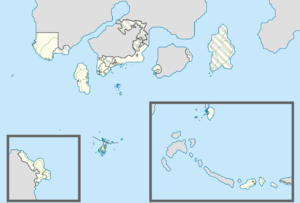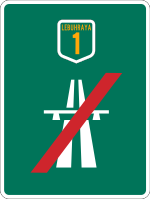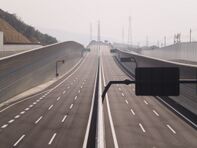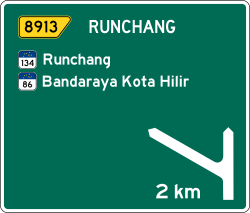Phinbellan Expressway System: Difference between revisions
| (One intermediate revision by the same user not shown) | |||
| Line 53: | Line 53: | ||
==== Phinbellan Euran States ==== | ==== Phinbellan Euran States ==== | ||
[[File:Terowong Pengkalan Sapi, Singapore Street.jpg|thumb|227x227px|[[Pengkalan Sapi Tunnel]] in [[Singapore Street]], [[Kōkai]]]] | [[File:Terowong Pengkalan Sapi, Singapore Street.jpg|thumb|227x227px|[[Pengkalan Sapi Tunnel]] in [[Singapore Street]], [[Kōkai]]]] | ||
[[File:Lebuhraya Link Kedua Sundar.jpg|thumb|197x197px|[[Sundar Second Link Expressway]] towards [[Glayzer]]]] | |||
The history of highways in the region of the [[Phinbellan Euran States]] actually started in the end of {{RP|1984}}s to the early {{RP|1994}}s and it was the earliest region to have an express highway built, even it was built for several years before merging with Phinbella under the sovereignty of the Order of the Holy Lakes. | The history of highways in the region of the [[Phinbellan Euran States]] actually started in the end of {{RP|1984}}s to the early {{RP|1994}}s and it was the earliest region to have an express highway built, even it was built for several years before merging with Phinbella under the sovereignty of the Order of the Holy Lakes. | ||
The main reason for the construction of the expressway in the region of the Phinbellan Euran States is the size of the main metropolitan area in the region which is increasing especially in metropolitan areas of [[Singapore Street]] in [[Kōkai]] and [[Høkō]] in [[Shandānø'kaí]], the surrounding township also experienced rapid growth and development in the early {{RP|2004}}s. The [[Phinbellan Euran Corridor Economic Region]] (PhinECER) was established shortly after the merger of the region. The two major cities in the region achieved city status in {{RP|2000}} (Høkō) and {{RP|2004}} (Singapore Street) respectively. The construction of expressways in this region is not focused on the | The main reason for the construction of the expressway in the region of the Phinbellan Euran States is the size of the main metropolitan area in the region which is increasing especially in metropolitan areas of [[Singapore Street]] in [[Kōkai]] and [[Høkō]] in [[Shandānø'kaí]], the surrounding township also experienced rapid growth and development in the early {{RP|2004}}s. The [[Phinbellan Euran Corridor Economic Region]] (PhinECER) was established shortly after the merger of the region. The two major cities in the region achieved city status in {{RP|2000}} (Høkō) and {{RP|2004}} (Singapore Street) respectively. The construction of expressways in this region is not focused on the major city and its surroundings, but is also built to connect with the hinterland and also to the border areas, especially to [[Desaremix]], [[Rocher]] and several cities in [[Banh Nam]]. | ||
===Negara Awan and New Territories area=== | ===Negara Awan and New Territories area=== | ||
Latest revision as of 16:22, 29 September 2024

|
This article or section is a work in progress. The information below may be incomplete, outdated, or subject to change. |
| Phinbellan Expressway System Sistem Lebuh Raya Ekspres Phinbella 핀벨라 고속도로 체계 Phinbella Gosokdoro Chegye | |
  Symbol and highway shield of the Phinbellan expressways | |
 Map of Phinbellan expressway network as of today. | |
| System information | |
|---|---|
| Maintained by respective concessionaire companies; numbers and routings assigned by Phinbella Expressway Authority (PHXA) | |
| Length | 1,799 km |
| Formed | -4BP |
| Highway names | |
| Expressways |
|
| System links | |
|
Expressways · Federal · SAT · Territory · Tourist | |
The Phinbellan Expressway System (Phineaner: Sistem Lebuh Raya Ekspres Phinbella; Taesongean: 핀벨라 고속도로 체계; RR: Phinbella Gosokdoro Chegye) or known as the Federal Expressway (Phineaner: Lebuh Raya Ekspres Persekutuan; Taesongean: 연방 고속도로; RR: Yeonbang Gosokdoro) is a network of controlled-access expressways in the Federal Republic of Phinbella, the realms of the Order of the Holy Lakes. All expressways in Phinbella are dual carriageway with access to level isolation via a multi-storey intersection. Each highway in Phinbella has 6 lanes (3 for each direction of travel) but some also have 8 lanes to accommodate high traffic flow rates. The network began with the construction of the Pan Islands Expressway in -4BP which connects several urban and enclaved areas in the Maritime Kachi Kochi. All Phinbellan expressways are built by the Phinbellan Expressway Corporation and several other concessions are under the supervision of the Phinbellan Expressway Authority (PHXA or LLP). Phinbellan expressways have a length of 1,799 kilometers across Phinbella.
History
Interstate
Before the toll expressway was introduced in the early -2BPs, many Phinbellans traveled throughout the Phinbella area using existing roads.
Among the main reasons for building a new expressway in Phinbella are the increase in population in major cities and towns, land exploration, and the opening of new settlements, major ports and airports.
In -10BP, the Highway Planning Unit was established under the Public Works Authority.
On January 20, -4BP, the Pan Islands Expressway was built, this 69.1 kilometer expressway was built in two phases; the first phase is from Ume Momo to San Fransōkyō, while the second phase is across Territory of Halim area and the enclaved collectivities of the Maritime Kachi Kochi from San Fransōkyō to the city of Cyborges. This expressway was completed in RP 2603. The Pan Islands Expressway also built a third phase route connecting San Fransōkyō to Rintis Island, it was first built in RP 2605 and completed in RP 2609. It also facilitated travel from Ume Momo, Cyborges and San Fransōkyō to Rintis Island. This expressway is an interstate highway that connects the dependent territory area (Maritime Kachi Kochi) with a territory within the free area of the Federation (Territory of Halim).
The Trans-Southwest Coastal Expressway began construction in RP 2612, it started with the construction of the toll section of the Serambi–Jambil Expressway from Sungai Selamangan to the North Jambil toll plazas, and it was opened in early RP 2613. The project continued with the next section, where the stretch of Iñderaqonır–Telok Melangar, Kediros–Sungai Mitsubishi and Jambil–Nunukawan was opened in September RP 2613. Meanwhile, the stretch of Sungai Sibugak–Tenowar and Air Kumbahan–Lening was opened to traffic in December RP 2613. The stretch of Iñderaqonır–Tushkardan was opened in mid-RP 2614 to facilitate the journey back to the hometown during the Aidilfitri celebration. Meanwhile, the Dezek–Kijal stretch will open at the end of RP 2614. In early RP 2615, the closed toll system will take effect along the stretch of Telok Melangar–Air Kumbahan and Sungai Sibugak–Jambil.
Intan Wan Pat Bridge-Tunnel is a bridge and tunnel at the same time an expressway that crosses the Amrok Strait and the Captive Sea that connects Rimba Raya and Cyborges, it also crosses several islands administered by the Phinbellan Minor Outlying Islands. Intan Wan Pat Bridge also has a railway under the bridge, it is the longest bridge in Phinbella because it has a length of over 388 kilometers. This bridge was built since RP 2605 and is said to be completed in RP 2615 although during construction it is already passable instead of them having to board a plane or cruise in the beginning, this bridge makes it easier for them to travel from Rintis Island, Ume Momo or San Fransokyo to the Negara Awan, Cyberaya or Kota Hilir.
Phinbellan Euran States
The history of highways in the region of the Phinbellan Euran States actually started in the end of -20BPs to the early -10BPs and it was the earliest region to have an express highway built, even it was built for several years before merging with Phinbella under the sovereignty of the Order of the Holy Lakes.
The main reason for the construction of the expressway in the region of the Phinbellan Euran States is the size of the main metropolitan area in the region which is increasing especially in metropolitan areas of Singapore Street in Kōkai and Høkō in Shandānø'kaí, the surrounding township also experienced rapid growth and development in the early RP 2600s. The Phinbellan Euran Corridor Economic Region (PhinECER) was established shortly after the merger of the region. The two major cities in the region achieved city status in -4BP (Høkō) and RP 2600 (Singapore Street) respectively. The construction of expressways in this region is not focused on the major city and its surroundings, but is also built to connect with the hinterland and also to the border areas, especially to Desaremix, Rocher and several cities in Banh Nam.
Negara Awan and New Territories area
Since Negara Awan was rebuilt and abandoned areas upgraded, and made the new capital of Phinbella in RP 2616 replacing Bandar Baru Fatin, the Phinbellan government has planned to build a new airport and port nearby as the main gateway to the capital, as well as plan to connect the capital with the Rimba Raya and the rural areas of the New Territories. As a result, the federal government has planned to build a first expressway linking the new airport and the capital, and the project has started in early RP 2617. The expressway will pass through the residential areas of The Istana and the Hangang Strait.
At the same time, the federal government also plans to build an expressway to connect the Negara Awan, New Territories and the Orange Free State. Since Negara Awan has just been occupied, it is likely that there will be an increase in indigenous population in the New Territories and a lot of township construction plans around it, it would be reasonable to build new highways in this territory.
The Highland Bank-Carpatho-Ïeu'ryádoche Dispersal Expressway is an expressway with an open toll system connecting Batang Padang in Highland Bank and Saporok in the Carpatho-Ïeu'ryádoche region within the Ïeu'ryádoche District. The interstate expressway is an expressway that has diamond and half-diamond intersections and is dotted with houses and villages on the side of the road, it is also built to connect with recreational areas along the expressway. This express highway started to be built in early January RP 2617 and is expected to be completed in RP 2619 and it will facilitate the journey from Saporok to Negara Awan.

Directly-administered metropolitan cities
Phinbellan Maritime Territories, Permata Mutiara and Ross Dependency
Phinbellan Unincorporated Territory
The history of the highway in Phinbellan Unincorporated Territory began in the RP 2600s (most likely it began in -4BP) when the government proposed to connect several settlements or towns in main remote archipelagos in the west and interior area in the eastern part of its territory.
The Bandar MEC-Tampines Broadcasting Highway is the first toll-free highway in the unincorporated territory, which was completed in RP 2600, connecting Bandar MEC, Hulu Teming town center (where the old Keopuchean Broadcasting System headquarters is located), Dimmsdale town and the city of Tampines along 28 kilometers. The Dimmsdale-Port Juoh Expressway is a tolled expressway connecting the town of Dimmsdale and the Port Juoh which is the main gateway to the Skypiea Islands, and it was built as a two-lane highway. The Karnarartakert Niigatavas Bridge is the first bridge to be part of the Broadcasting Highway, is the first toll bridge, but two years after its opening, the toll on the bridge was abolished in RP 2604.
The Elphinstone Islands, a remote archipelago in the Phinbellan Unincorporated Territory with a relatively dense area and large population density, has seven expressways connecting several settlements and towns on its main islands such as Padang Polo Exchange, Telipod, Pasio Hur, Pertengahan Gong and Kamelia Hill. Only three expressways in the archipelago are tolled. Construction of expressways in the archipelago began around the RP 2600s. The first expressway in the archipelago is the Merapok-Padang Polo Expressway which connects Padang Polo Exchange via Pasio Hur Interchange and Merapok for 38 kilometers, and across the southern islands and town of Merapok via the 12-kilometer-long Cahaya Mata Bridge, it was first built in RP 2600 and completed in January RP 2606.
A new highway project to lead to its local airport, Bukit Kamelia Airport was built in RP 2604 and its 6-kilometer route connects the town of Padang Polo and the airport, and it is named the Bukit Kamelia Airport Expressway, and it is a spur link for the main expressway of the Elphinstone Islands. Other expressways in the archipelago are now being made federal routes after concessions handed them over to local governments and the Works Authority, and subsequently the toll was abolished in RP 2613, except for the Merapok-Padang Polo Expressway operated by MTD Prime.
The expressway project on the remote large islands of the Phinbellan Unincorporated Territory is the Pikas Bypass which connects the town of Pikas and the Trans-Jordan Hill National Park on Tandorukan Island.
The Gugusan Rainbow Ferbnessa is part of the Phinbellan Unincorporated Territory is also not spared from having its own highway, where a new expressway project in the Ferbnessa Division has been announced by the government. Construction of Ferbnessa’s first expressway connecting the division’s major towns has begun in RP 2616.
Features
Expressway standards
The construction, standardization, maintenance and use of expressways in Phinbella are subject to the Expressway Private Management Act 2615. Expressways in Phinbella have six lanes (three lanes each direction) and two lanes for motorcycles and bicycles. The expressway at Phinbella is very special as it can be traversed by all types of traditional vehicles, private vehicles (including motorcycles and bicycles) and other public vehicles such as buses and taxis.
Expressways are constructed as high-speed highways with LKRP LB6 highway standards, with almost all expressways having six lanes (three lanes each direction), and most having four lanes (two lanes each direction), and all expressways having full access control. It also has a separate grade intersection and a high speed limit design. All expressways are administered by the Phinbella Expressway Authority and several concession companies respectively under this board.
Phinbellan expressways set a maximum high speed limit of 110 kilometers per hour on almost all of them and a maximum of 80 to 90 kilometers per hour on urban expressways and highland expressways.
Route numbering
At the beginning of the construction of the first expressway, there was no expressway specific numbering system, but in RP 2610, as many expressways were built, the expressway numbering system was introduced and accepted on all expressways. The expressway has been labeled with the name "LEBUHRAYA" followed by the designated number as it appears on its highway shield or route marker, for example, the Pan-Islands Expressway connecting Ume Momo through the territory of Halim is designated as "LEBUHRAYA 1".
Auxiliary expressways such as spur, parallel and city ring expressways are allocated with main expressway routes with additional two-digit number suffixes. The first digit of the number suffix is allocated with the number “1” for spur highways, the number “2” for parallel highways and “0” for inner and outer loop or ring expressways, such as Tanjung Baruk-Bukit Melapoh Expressway which is part of the Trans-Southwest Coastal Expressway (E12), allocated under the name "Expressway 12-13" (E12-13), and another example, the Tampines Outer Ring Road Expressway is designated as the Expressway 48-02 (E48-02).
| Examples | Information | Number digits |
|---|---|---|
| Primary route numbers | E01–E99 | |
| Auxilary route numbers | E0111-E9919 E0121-E9929 E0101-E9909 |
Exit numbering
The expressway exit ramp numbering system is formatted xxnn, where "xx" is the expressway code number, and "nn" is the two -digit number assigned to each highway lane. For example, is the exit number 0348, where "03" is the expressway route number 3, and the other two digits "48" are the assigned exit number. Another example, exit number 3208, where number "32" is expressway route 32 and number "08" is the eighth exit. The expressway at Phinbella has distance markers in white with a green background, and is placed every 100 meters.
Pavements
Almost all expressways in Phinbella are paved with cold asphalt, because the climate conditions in Phinbella are diverse, starting from a cold climate to a tropical climate, and there are some expressways that are paved with tarmac (a mixture of tar and fine stone chip fragments) especially build in the tropical climates areas. Where almost all road sections are paved with asphalt, some sections of the road are paved with tarmac. Meanwhile, highway routes at tunnels, intersections and toll plazas have been paved with concrete, or using bricks. There are express highways in Tanah Baharu, especially in desert climate areas, usually paved with concrete.
Toll system
Every highway and expressway in Phinbella has a toll system, either in an open system or a closed system. Each transaction is in the national currency, Phinbellan florin (ðƒ).
The national expressway is cheap to use, where travel from Negara Awan (via the Straits junction from this city) to Kota Hilir (via the Runchang junction) on the Tanah Rata-Cyberaya Expressway has cost ðƒ14.40 in tolls for private vehicles such as cars.
Very different from the highway system in other countries in Micras, the toll on the expressway in Phinbella is based on the inbound and outbound travel of one intersection to another intersection. As usual, when entering an expressway, a person takes a transit ticket or transit card, and pays the amount of toll charged at the exit toll plaza, and also hands back the transit ticket or transit card to the attendant when exiting the expressway. Most expressways in Phinbella use a transit card system, and a small number of expressways use a transit ticketing system or use a unitary fare charging system.
The rate of this toll fee depends on the type of vehicle specified as shown in the table below.
| Type of vehicle | rate in ðƒ per interchanges |
|---|---|
| Bicycle, other traditional vehicles | 0.80 |
| Light car, tuk-tuks and motorcycle | 1.20 |
| Taxis, minivan, sedan and pick-ups | 2.60 |
| Small and medium-sized truck | 4.40 |
| Bus, double decker | 1.50 |
Since RP 2606, the toll fee consists of a terminal charge of 50 shillings (ðƒ0.50) plus the existing fee.
Electronic toll collection
Phinbella has just adopted a network of electronic toll collection (ETC) systems, where it has been installed in many cars, automatically paying at the toll gate. New signs of the three types of ETC will be shown on the increasing number of toll gate lanes. There are five types of electronic toll collection (ETC) systems, TouchVerse card units, SBCPass card units, unknown card units, on-board ExTAG units, PhinRFiD tags and contactless credit/debit cards, and they are mandatory starting January RP 2617 on all expressways in Phinbella, however, there is a separate electric toll collection system for the region or for certain concessions and it also happens on expressways in certain regions or concessions. There is one type of ETC system is different in use according to the operation of the respective expressway network. The ETC network based in Negara Awan, Bandar Baru Fatin and Tri-State Area all feature mixed toll routes that support this carded toll payment system or dedicated full-service ETC lanes.
| Other expressway concessionaries | |||||
|---|---|---|---|---|---|
| Electronic toll collection systems vs Payment method | TouchVerse ExTAG |
SBCPass | TouchVerse | POV RFiD | |
| PhinRFiD | VEP RFiD | ||||
| TouchVerse Card - Generic Card - Corporate Card - Zing Card |
|||||
| TouchVerse eWallet | |||||
| SBCPass Card | |||||
| Bank Card (Debit/Credit) | |||||
| Notes | |||||
Multi Lane Free Flow
Facilities
On the expressway in Phinbella, just like the expressway network in most countries in Micras, it also has many facilities, but there are facilities that are not available in other countries, among the facilities found on this expressway network are:
- Rest and Service Areas – Rest and service areas (RSAs) are located approximately every 60 to 90 kilometers along interstate expressways, and most urban expressways also have rest and service areas. The RSA in Phinbella may have a food court, fruit stalls, craft shops, public toilets and baths, public telephones, huts (waqf), gas stations and mosques for Umraists, different from Forajasaki and other Micras countries, on the basis of harmony race and faith in Phinbella, RSA in Phinbella has places of worship for other religions such as temples and small shrines, also churches. All rest and service areas in Phinbella have ATMs and motels, as well as convenience stores, not only that, there are also fast food restaurants. Wireless broadband internet facilities are now available in RSA.
- Layby – Layby is a basic parking lot next to the expressway that may also have public toilets and showers, fruit stalls, huts (waqf) and public telephones, in Phinbella only, laybys only have a surau for Umraists to perform their prayers. Unlike in other countries, layby should not have food stalls. Between the two RSAs, that's where the layby is located.
- Flyover restaurant – Flyover restaurant is a special rest and service area with a restaurant above the highway. Unlike normal public and RSA which can only be accessed in one direction only, the upper restaurant can be accessed from both directions of the highway. Interestingly, the bridge restaurant in Phinbella also has stalls dedicated to selling luxury goods, accessories and clothes like a shopping mall. In Phinbella there are eight bridge restaurants, and there will be new bridge restaurants to be built including the one located in Tanah Baharu.
- Customer Service Center (CSC) – Every toll plaza in Phinbella has a customer service center, usually it is located on the right side of the toll plaza on the interstate expressway, while almost some urban expressways do not have a customer service center. The center includes a highway map, toll fare list, information counter, card top-up counter, sales counter and more.
- Vista Point – Vista Point is a special parking area that allows drivers to have a great view of the expressway; usually located in an area close to a recreational area. A Vista Point that is famous for the sighting of the moon when the Aidilfitri, Aidiladha and Ramadhan celebrations are approaching is a Vista Point located in Kuala Koh, Tanah Adélie district.
- Motorcycle and other vehicle-type shelters – Just like on expressways in other countries, motorcycle shelters provide shelter and protection for motorcyclists from heavy rain. Usually, most motorcycle shelters are located under the overpass, but some may be special stalls. However, in Phinbella, shelters are also used by different types of vehicles such as bullock carts, horse carts, rickshaws and so on.
- Motorcycle lanes – In some sections throughout the expressway, there are additional lanes designated for motorcycles. These lanes are usually about half the width of normal lanes and are placed on the extreme left of the main road in each direction of travel. All expressways in Phinbella have motorcycle lanes.
- Transit lanes for different types of vehicles – just like motorcycle lanes, transit lanes for different types of vehicles are also available in Phinbella, and almost all expressways including urban expressways have them, but these lanes are as wide as normal lanes or at least 3/4 wider than a normal lane.
- Emergency telephones – Emergency telephones are located every 2 km along interstate expressways; useful if there is damage on the expressways. Officers from the nearest toll plaza will tow the damaged car to the nearest workshop.
- Expressway hotline service – Every expressway has a hotline service.






